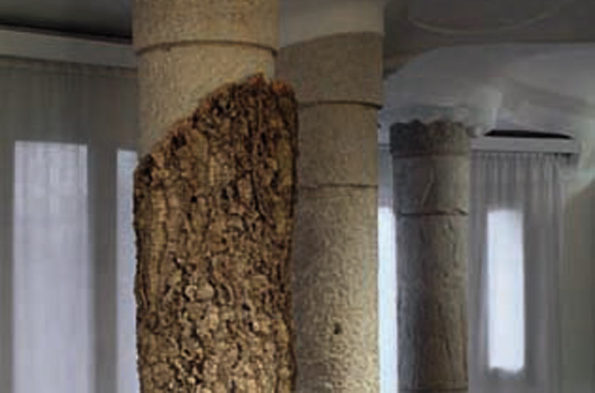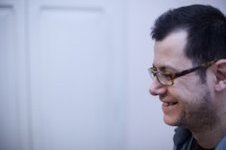Search
To search for an exact match, type the word or phrase you want in quotation marks.
A*DESK has been offering since 2002 contents about criticism and contemporary art. A*DESK has become consolidated thanks to all those who have believed in the project, all those who have followed us, debating, participating and collaborating. Many people have collaborated with A*DESK, and continue to do so. Their efforts, knowledge and belief in the project are what make it grow internationally. At A*DESK we have also generated work for over one hundred professionals in culture, from small collaborations with reviews and classes, to more prolonged and intense collaborations.
At A*DESK we believe in the need for free and universal access to culture and knowledge. We want to carry on being independent, remaining open to more ideas and opinions. If you believe in A*DESK, we need your backing to be able to continue. You can now participate in the project by supporting it. You can choose how much you want to contribute to the project.
You can decide how much you want to bring to the project.

The art space at La Pedrera, in Barcelona, presents an exhibition of Perejaume. If MACBA in 1999 already dedicated a retrospective to him, the current moment encompasses the work of an artist that moves between language, landscape and poetry, interpreting them by way of a caricatured nationalism. The leap from conceptual art to wit is sometimes complicated.
Despite bringing together work by the artist from since the middle of the nineties, this exhibition announces that it is not a conventional retrospective. One is warned that, by inscribing the exhibition in the emblematic space of La Pedrera, the disposition of the works will establish a dialogue with its spaces. In proposing a continuum with the façade of the building, Martí Peran, the curator, also describes the exhibition in general as a reflection upon the excess quantity of works of art, and from there, the culture of excess of western societies. The title in itself refers to this, “Ai Perejaume, si veies la munió d’obres que t’envolten, no en faries cap de nova!” (“Oh Perejaume, if only you could see the mountain of works around you, you wouldn’t make any new ones!”), but, personally, I think that these words are left like a sequence of rhetorical tricks, a failed attempt to introduce certain effects through discourse, in an exhibition where, if anything is made manifest, it is none other than the exhaustion of certain proposals and strategies articulated by the author, Perejaume.
Luis Camnitzer, in one of his essays about Latin American art, poses the paradox that an art, such as conceptual art, based on ideas and dematerialization, has succumbed to the formal finesse adjudicated to it by its pioneers. Something similar could be said about land art, given that the radiation of its ideas in many occasions is also impregnated with elements that are characteristic of the North-American landscape. But neither of these is the case of Perejaume, who above and beyond any other label from the historiography of art, has always preferred to identify himself as a plenairist. And with Jacint Verdaguer (1845-1902), of whom he says: “we find the idea of the plenairist better represented by the poet Jacint Verdaguer than by any of the actual painters of the school of Olot (emulators of the French Barbizon school), who adhered at the same time as Verdaguer, to what could be called a strict form of en plein air activity.”
The identification of Perejaume with the poet from Folgueroles, is thus twofold: given the literary interpretation but above all the literal one that he made of the term en plein air – “the unattainable vocation to make nature, in nature, the image of nature”-, but also for having known how to establish landscapes that didn’t succumb to the formal layouts of the woods of Fontainebleau that at that time were being imported to the Garrotxa. In effect, Perejaume, unlike the tonic that is the norm among the epigones of conceptual art, has also drunk from the traditions of contemporary art practice, although he has displaced its epicentre in numerous occasions to instigate processes of hybridisation, with landscapes, customs, language and above all dialectic variations, more intensely than probably any other Catalan artist of his generation, or let’s say, artistic descent.
The catalogue of the retrospective that MACBA gave the artist in 1999 opened with his own words: “Language covers”. From my point of view, the best that Perejaume has generated occurs when it is situated on this very surface, challenging the relation between landscape and art, understanding both as performative languages, as ways of looking at and constructing the world. His series where he places frames and fragments of them in natural spaces are well known, establishing relations of novel contiguity or discontinuities, altering the location of meaning and making it turn in unexpected directions. Equally he has done it with the physical displacement of works of art to physical sites, or vice versa, evidencing the miniaturisation of fragments of landscape, that is required – in what he calls pessebrism – in order for them to enter into museum spaces.
Art as a generator of landscape, and vice-versa. Up to this point it’s as if we were in a game of deconstruction, one at which the artist has demonstrated his virtuosity, offering witty ideas. However, the fact that language “covers” has, at least one drawback. As the text we have quoted continues, “so many exercises in writing about a background of reality have led us to think that there wasn’t such a background”. What we have here is a background reality underlying language. A vanishing point between linguistic collisions, the presence of an element, that transcends the surfaces that the artist traverses, exchanging cultural elements. On the walls of la Pedrera, more than ten years after the retrospective at MACBA, I believe that it is finally made manifest. Or at least, in the case of this background reality, one prefers to consider it as a persistent feature of the whole of the artist’s work, that here in la Pedrera one would have to say is reveals in a rather maladroit manner.
The background reality emerges more forcefully according to the measure with which the irony softens and seeming to suture precisely where the injury had been produced. Paradoxically this background reality is presented as neither split nor traumatic, the fruit of a conflict that language has not been able to resolve. And thus, despite the deconstruction of cultural elements, like the theatre curtain, the canvas and frame of painting or the museum space, Perejaume leaves intact some signs that make it possible to identify him as an artist, who does and undoes with pieces from his surroundings, at practically the same time as he builds himself as a humanist. In the case of la Pedrera there are two verbal dialogues between the artist and the pictorial materials, which, given their limited resemblance I’m no longer sure if they should be considered as cases of meta-language or if they point to Perejaume being crowned as a sort of artist with magical powers.
On the other hand, a second series of cultural norms that, rather than entering into collision, practically receive praise, are those related to Catalan culture, that are literally, like the identity of the artist, revealed as a unity or transcendent truth. Formulated to a large extent as a way of bringing into play elements of the landscape, Martí Peran in the catalogue interprets Perejaume as laying the grounds for the “traits of a telluric policy”, a form of cultural resistance against the colonialism of globalisation. Since the turn of the millennium, religious elements, such as ex-votos or halos, have also been introduced into his work, underlining this relationship between place and its transcendence. While at the same time probably making this relationship more caricatured and naïve, and as far as I’m concerned ultimately contributing to distance Perejaume from tackling cultural and artistic questions in a more realistic and obviously hybrid fashion. Two aspects that I believe would be inseparable from the attitude of a plenairist in the 19th century, as much as they are at the beginning of the 21st.

Oriol Fontdevila thinks that the political and social dimensions of art practices and cultural phenomena are interesting; that the question of cultural innovation ought to be dealt in correlation with that of social progress: that cross-disciplinary working is an opportunity, not just to accumulate knowledge, but to generate surroundings from where to challenge them; and that art criticism and curating can contribute in this respect.
"A desk is a dangerous place from which to watch the world" (John Le Carré)